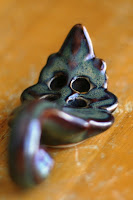Sam! More specifically “Cavity Sam”, who in 2004 came down with an additional affliction, Brain Freeze (you know, from drinking a slurpie / slushie to fast?). It tallied more votes than either Tennis Elbow or Growling Stomach in the naming contest.
Game History
The game was born in 1962 when student John Spinello designed a very simple version for an industrial design class project. Fortuitous circumstances had John selling the design to a small firm who developed a game from his concept, “Death Valley”, in which players went on a search for water in the desert. When Milton Bradley got their hands on the game in 1965 it was redesigned, and became the game themed in a hospital operating room we know today.
The original 1965 version is the “holy grail” of Operations games. For starters it has a doctor smoking on the box, tapping his ashes in Sam’s face. Imagine how this would go over today! The original game has a slanted key through the Milton Bradley Logo rather than a key lying horizontally underneath the logo. The original game instructions were printed on the inside cover of the box, not on a paper insert. Additionally the first version has “Electric Game” in green lettering, and later versions say “Skill game” in black.
The body parts
Adam's Apple: in the throat; The Adam's apple is a colloquial term referring to the thyroid cartilage surrounding the larynx that becomes more visually prominent during puberty. Worth 100 points.
Broken Heart: a heart shape with a crack through it on the right side of the chest. The phrase "broken heart" refers to an emotional feeling in which someone is very sad for some reason. 100 points.
Wrenched Ankle: a wrench in the right ankle. 100 points.
Butterflies in the Stomach: a large butterfly in the middle of the torso. The name comes from the feeling in the stomach when nervous or afraid. 100 points.
Water on the Knee: a pail of water in the knee. Colloquialism for fluid accumulation around the knee joint. 150 points.
Funny Bone: a play on the anatomical name for the upper arm bone (the humerus), and a reference to the colloquial name of the ulnar nerve. 200 points.
Charley Horse: a small horse resting near the hip joint. A play on the real charley horse, which is a sudden cramp in the leg or foot, that can be cured with massage or stretching. 200 points.
Writer's Cramp: a pencil in the forearm. Refers to the real writer's cramp which is a soreness in the wrist, and can be cured resting it. 200 points.
The Ankle Bone's Connected to the Knee Bone: This is not a plastic piece, but rather a rubber band stretched between two pegs at the left ankle and knee that has to be unhooked. 200 points. The name is taken from the African-American spiritual "Dem Bones".
Wish Bone: located on the left side of the chest. A "wish bone" is a chicken bone which is traditionally used by two people to make a wish on. 300 points.
Bread Basket: a slang word for the stomach, this is a difficult piece to remove. It is a very small slice of bread, with only a small notch taken out of the top for grip. 1000 points.
The toe bone connected to the heel bone,
The heel bone connected to the foot bone,
The foot bone connected to the leg bone,
The leg bone connected to the knee bone,
The knee bone connected to the thigh bone,
The thigh bone connected to the back bone,
The back bone connected to the neck bone,
The neck bone connected to the head bone.
The heel bone connected to the foot bone,
The foot bone connected to the leg bone,
The leg bone connected to the knee bone,
The knee bone connected to the thigh bone,
The thigh bone connected to the back bone,
The back bone connected to the neck bone,
The neck bone connected to the head bone.
More?





























